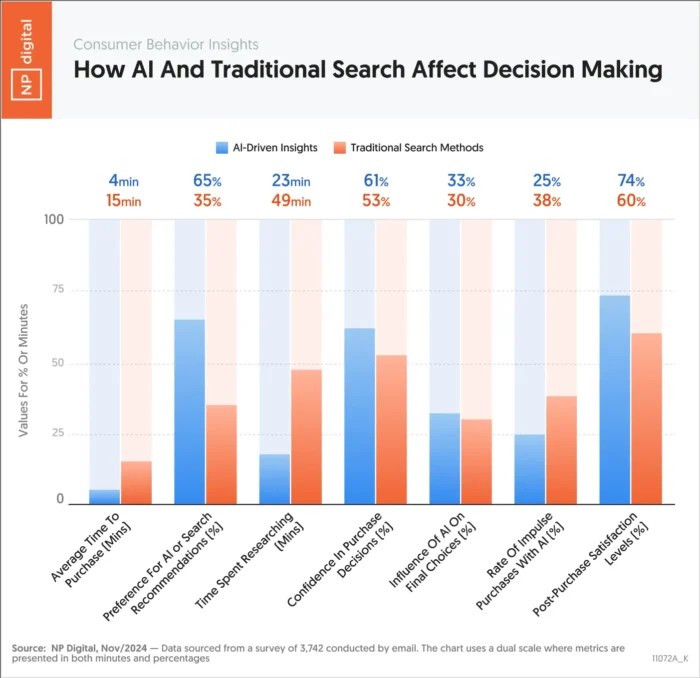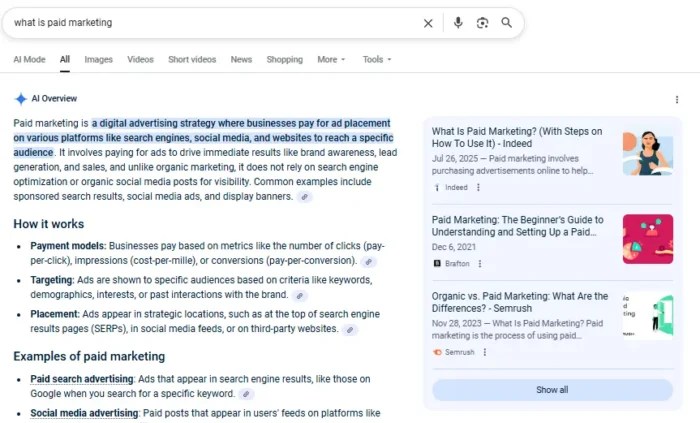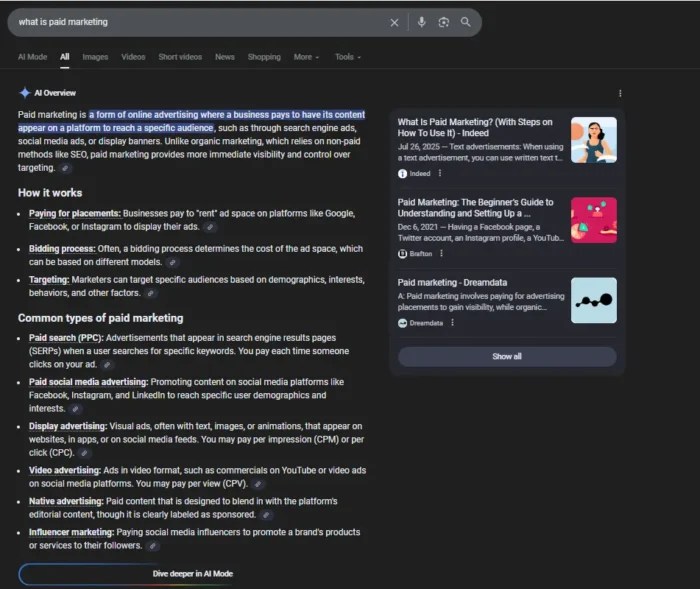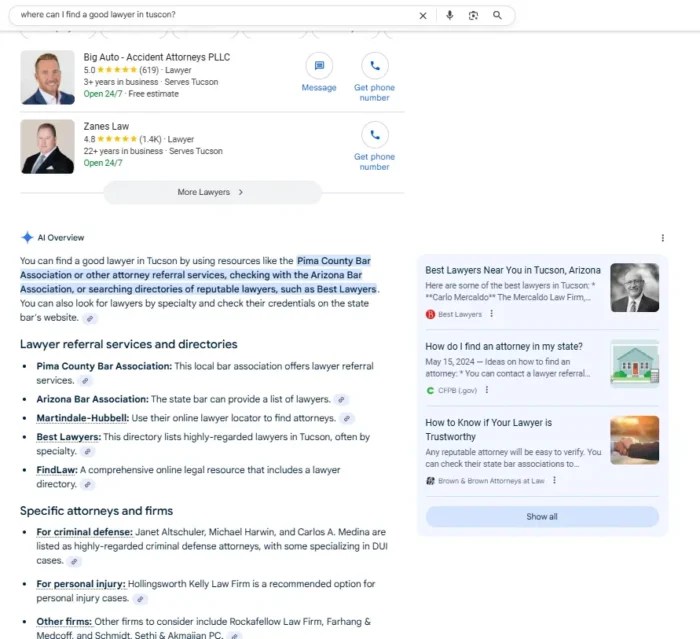AEO (Answer Engine Optimization): How to Get AI Generator to Mention my Business
More than half of searches in 2025 don’t lead anywhere. People get answers from ChatGPT, Perplexity, and Gemini without clicking a single link.
Not showing up in those responses? You’re invisible to half the internet.
That’s where answer engine optimization (AEO) comes in. It helps your brand become the answer that AI tools deliver.
This guide breaks down how AEO works, how it compares to SEO, and what steps you can take to make your content more findable across modern search platforms.
Key Takeaways
- Around 60 percent of searches now end without a click. Answer engines like ChatGPT and Perplexity deliver results without sending users to your site.
- Answer engine optimization helps your content show up in AI-generated responses and voice search results.
- AEO extends your SEO strategy by focusing on visibility in conversational and zero-click search environments.
- To win in AEO, you need to optimize for direct questions, structured answers, user intent, and authority signals.
- AI-first search is already shifting user behavior. The earlier you adapt, the more visibility you’ll protect.
What is Answer Engine Optimization?
Answer engine optimization (AEO) makes your content easy for AI tools to find and use as a direct answer.
This started with rich results in Google like Featured Snippets and People Also Ask, but today, AEO is about showing up in a full ecosystem of AI-driven answer engines like ChatGPT, Perplexity, Gemini, and Google’s AI Overviews.

While there are technically still links as a part of these tools, there’s no guarantee a user will click on them.
Your content needs to match how large language models (LLMs) process information if you want to appear in those answers. This includes:
- Natural language clarity
- Structured data and schema markup
- Topical authority and entity-level signals
- Inclusion in knowledge graphs and trusted datasets
These systems rely on machine learning and natural language processing to determine what content best fits the user’s query. If your site structure and content format aren’t optimized for this, you are less likely to be cited.
AEO isn’t some future tactic. It’s how visibility works now.
Why is AEO Important?
Search has changed. It’s not just about blue links on a results page anymore. Tools like ChatGPT, Perplexity, and Google’s AI Overviews are changing how people access information and how brands show up.
The rise of these answer engines has led to a sharp increase in zero‑click searches. In many cases, users now get what they need without ever visiting a website. That means if your content isn’t optimized for those responses, you’re missing visibility.

Voice assistants like Alexa, Siri, and Google Assistant work the same way. As generative AI improves by summarizing the web, fewer sources get shown per query, putting more pressure on marketers to be the one selected.
People expect answers fast. They won’t scroll through ten links when one will do. AEO is about aligning your content to that expectation: clear answers, fast.

And the impact isn’t just on organic traffic. AEO boosts brand visibility, strengthens trust signals, and improves discoverability across AI tools and platforms. If you’re investing in SEO but ignoring answer engine optimization, you’re missing opportunities.
How is AEO Different Than SEO?
AEO and SEO work toward the same outcome (getting your content discovered) but the paths they take are different.
Search engine optimization (SEO)focuses on improving rankings within search engine results pages. That includes optimizing technical elements, matching content to user intent, building links, and improving site structure. It’s about increasing visibility across a range of possible results.
Answer engine optimization (AEO) focuses on earning the single, summarized response delivered by an AI system. These systems rely more heavily on structured answers, clarity, and content that fits within specific answer formats. You’re competing for the only spot that gets shown, not position ten.
AEO is often confused with Generative Engine Optimization (GEO), which is related but distinct. GEO focuses on creating content that gets cited by AI tools as a source. AEO focuses on optimizing existing content to be surfaced directly within the answer. Both matter, but they solve different problems.
What Are AI Hallucinations And How Can You Avoid Them?
AI hallucinations happen when tools like ChatGPT give answers that sound right but are completely wrong. This happens when AI pulls outdated, misattributed, or low-quality information when summarizing information.

In one example, users asked a chatbot for medical advice and received fabricated product suggestions. Other tools have invented studies, misquoted statistics, or pulled misleading content from forums.
The risk increases when a brand has little online authority or inconsistent information across platforms. If the AI can’t verify what’s real, it fills in the blanks and gets it wrong.
To reduce your risk of hallucinated results about your business:
- Keep your website and public profiles updated with accurate, consistent information
- Use schema markup and structured data to help AI interpret your content correctly
- Publish expert-led, well-cited content on topics you want to rank for
- Monitor where and how your brand is mentioned across platforms
Protecting your brand from hallucinations goes beyond technical fixes. It’s part of owning your visibility.
Strategies For Appearing In Answer Engines
Keywords alone won’t get you featured in AI responses. You need clear, credible, well-structured content that’s easy for machines to understand.
The strategies below are designed to help your site show up in AI summaries, voice results, and other answer-first formats.
Look at Your Existing Answer Engine Visibility
Before you start new optimizations, start by reviewing what’s already working. You may already have content showing up in AI searches like Perplexity, ChatGPT with browsing, or AI Overviews in Google.
Platforms like Ubersuggest Profound track brand and URL visibility across AI answers. These tools show what questions your site already ranks for, what sources AI is pulling from, and where gaps exist.

You can also run manual prompts in ChatGPT or Perplexity using branded and non-branded queries. Try asking questions you’d want your content to answer, and take note of what shows up.
This audit shows you where you stand and helps you prioritize. If certain pages are already being pulled into AI results, you may just need small tweaks. If others aren’t surfacing at all, you’ll know where to focus first.
Understand User Intent
Search engines, chatbots, and voice assistants all aim to solve one thing: what the user actually wants to know. That’s where search intent comes in, and it’s a foundational piece of answer engine optimization.
AI tools don’t just crawl your content. They interpret it. If your page doesn’t match the kind of answer a user is looking for, it likely won’t get picked.
Intent typically falls into four categories: informational, transactional, navigational, or commercial. But when it comes to AEO, you also need to understand how people phrase questions. “What is,” “how to,” “best tools for,” and “should I” are all common patterns.

So how can you learn the intent behind the keywords you’re targeting or ranking for? Keyword research tools, like Ubersuggest and Semrush can help.
Once you understand what search terms your website ranks for, you can dig into the most popular terms. Using Ubersuggest’s Keyword Overview tool, for example, lets you see search volume and SEO difficulty.

The keywords in the above screenshot are largely informational. The searcher is hoping to learn more about digital marketing. As we continue to scroll through the list of queries , we begin to see more commercial and transactional results.
Take “digital marketing platforms” as an example:

There’s certainly some informational intent behind the question, but it’s also possible to be commercial intent. For example, a business who is looking to subscribe to a platform may want to learn more about it so they can make the right decision.
If you’re a digital marketing agency with a platform, and you understand the intent behind that keyword, you can create content that captures the customer within the purchase journey.
Content that targets the transactional intent of this keyword may be a digital marketing platform or tool roundup. You can position your platform as the best option, or even create a post with affiliate links to other relevant platforms.
Intent matters as much as the question itself. This is why you must consider the whole picture when incorporating such keywords into your content.
Use The Direct Question/Answer Format When Applicable
If your content doesn’t look like an answer, AI tools won’t treat it like one. That’s why formatting matters more than ever in answer engine optimization.
Start by identifying the questions your audience is asking. Then give them a direct response near the top of your content, ideally within the first few sentences or paragraphs.
Use clear H2 or H3 headings for common queries. Add a dedicated FAQ section if your topic has multiple related questions. Bullet points, concise summaries, and short paragraphs all help AI models parse your content more accurately.

You’re not just helping users skim. You’re helping machines understand what your content is trying to say and where it fits.
Google’s AI Overviews, People Also Ask, and tools like Perplexity and Gemini all pull from content that’s been structured clearly and answers a defined question.

This is one of the simplest changes you can make to support AEO, and it pays off fast.
Set Up and Update Business Profiles Whenever Possible
Answer engines don’t just scan your website. They also pull from structured data across the web. That includes business directories, local listings, and public profiles.
Tools like ChatGPT and Perplexity can surface business info from places like Google Business Profile, Yelp, Apple Maps, and Bing. If your data is missing or inconsistent, your brand may be excluded from results.

Make sure your listings include accurate details like name, address, phone number (NAP), hours, and website. Add photos, reviews, and categories where possible. These signals all feed into the authority and relevance AI models look for.
Some key directories to prioritize:
- Google Business Profile
- Yelp
- Apple Maps
- Bing Places
- Yahoo! Local
- Yellow Pages
- Angi (formerly Angie’s List)
Don’t treat this as a one-time setup. Keep listings up to date, especially if your business has multiple locations or seasonal changes.
The goal is to make it easy for AI systems to confirm your legitimacy and context. You’re giving them structured proof of who you are and what you offer.
Become an Authority In Your Industry
AI systems scan for more than keywords. They look for trusted voices. If your brand is consistently cited, reviewed, and linked to across the web, you’re more likely to be featured in AI-generated responses. When we surveyed a group of marketing professionals who said that optimizing their content to appear in chatbot responses has been a major priority for them, 34 percent had the top goal of building brand awareness and loyalty.
That trust is built through authority. This includes third-party mentions, earned backlinks, expert-led content, and consistent appearances in respected directories or roundups.
Authoritative brands are also more likely to be surfaced in zero-click search, local packs, and answer engine results. Why? Because these platforms want to deliver credible information. If your site has proven expertise on a topic, it’s more likely to be chosen.
To build that authority, focus on publishing effective content, earning brand mentions in your niche, and contributing insights on third-party platforms. Guest posts, research, and interviews can all help grow your presence.
This takes time, but it compounds. The stronger a thought leader you are seen as, the harder it is for AI tools to ignore your content.
Incorporate AI Into Your Content Marketing Strategy
AI is changing how people search and how we create content. Used correctly, it can help you build pages that are more likely to surface in answer engines.
Start by using tools like ChatGPT to test your topic coverage. Ask sample questions your audience might type into an AI search. What comes up? If your site isn’t mentioned, or the answers are thin, you’ve found a gap to fill.
Many marketers are already leaning into this. In a survey we ran, over 81 percent of professionals optimizing for AI responses said they had been incorporating AI into their business processes for six months or more.

The top use cases included improving efficiency, sparking innovation, and enhancing customer experience. But AEO-focused content creation is where AI can deliver quick wins.
You can use AI to generate question-based outlines, draft summaries, or test how clearly your answers come across. Just don’t skip the human layer. Tools can help you move faster, but high-quality content still requires expertise.
Implement Schema Markup
Schema markup helps AI tools understand your content better. That can make the difference between being ignored or included in an answer.
Schema is a form of structured data that tells search engines and AI systems what your page is about. It adds a layer of clarity in the background without changing how your content looks to users.
For example, if you have a FAQ section, adding FAQ schema helps Google and answer engines extract that content more confidently. The same goes for how-to schema, product schema, article schema, and organization schema.
The more structured your content is, the easier it is for AI to match it to the right query. Schema also increases your chances of appearing in AI Overviews, People Also Ask, and AI-generated summaries.
You don’t need to add schema manually. Most SEO plugins, like Yoast or Rank Math, include built-in schema tools. There are also free generators available online if you want to apply it page by page.
Think of schema as a translator between your content and the AI tools deciding what gets shown. The clearer your signals, the better your visibility.
Review and Monitor Your AEO Progress
Answer engine optimization isn’t a one-time fix. Once you implement AEO strategies, you need a plan for tracking performance and making improvements.
Set a regular schedule to check whether your content is being picked up by AI tools. Look for patterns in which pages get cited, what queries they appear for, and where your visibility drops off.
This doesn’t require complex reporting. You can track progress using a simple spreadsheet, noting the presence or absence of your brand in AI summaries across key queries.
When something stops appearing, that’s your signal to re-optimize. Refresh the content, clarify the structure, or align it more closely with search intent. If something continues to perform well, look at what’s working and replicate that approach elsewhere.
AEO is still evolving, which makes monitoring even more important. The brands that adapt fastest will stay visible the longest.
What Factors Matter Most for ChatGPT Recommendations?
We ran a study to understand why ChatGPT recommends certain brands in its responses. After testing over 80 possible factors, six rose to the top.
Brand mentions: The more your brand is cited across the web, the higher the likelihood ChatGPT will surface it.
Reviews: Quality and volume of customer reviews, especially on third-party sites, play a major role.
Relevancy: If your site’s keywords match the user’s query, and the page offers helpful context, you’re more likely to get picked.
Age: Older, more established brands tend to be trusted more often by AI models.
Recommendations: Listicles and curated “best of” roundups (even those using affiliate links) still influence ChatGPT outputs.
Authority: High-authority domains with credible backlinks and consistent content earn more inclusion in AI answers.
You can’t control every factor, but you can influence most of them by building strong, reliable content that other sites and users want to reference.
FAQs
Answer engine optimization is the process of improving your content so it appears in AI-generated answers. It focuses on clarity, structure, authority, and accuracy—so tools like ChatGPT, Perplexity, and Google’s AI Overviews can pull your content as a trusted response.
It builds on traditional SEO but adapts it for zero-click and conversational search experiences.
Start by identifying the types of questions your audience is asking. Then create clear, concise answers—formatted with proper headers, schema markup, and supporting data. Use tools to track which content appears in AI results, and optimize based on visibility gaps.
Focus on building authority and publishing quality content that answer engines can trust.
AEO is about getting your content pulled into AI-generated responses. SEO is about ranking in search engine results pages. Both use similar tactics, but AEO requires more structured, answer-ready content.
Conclusion
AI is already reshaping how people search, and answer engines are gaining traction fast. If your content isn’t built for these platforms, you’re likely losing visibility—even if you’re ranking well in traditional search.
The good news: if you’ve been investing in SEO, many of the foundations are already in place. AEO simply takes it further, focusing on clarity, structure, and intent.
Tools like Ubersuggest can help you find question-based keywords, track content performance, and identify optimization gaps. From there, it’s about building better answers—and making sure they’re easy for AI to find.
Now is the time to get proactive. The longer you wait to adapt, the harder it’ll be to catch up.
Read more at Read More















































































